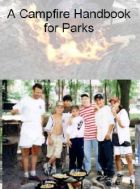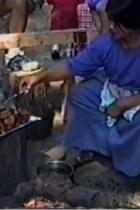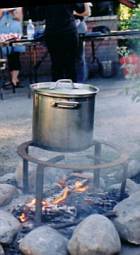Comments?
For the basics, see
- Website & Privacy Policies
- How To Get Involved
- The Role of the Park
Search options:
Department Site Map
Custodians:
 Campfire Recipes
Campfire Recipes
Campfire recipes
A lot of people use a campfire to cook hot dogs or toast marshmallows. If you want to go beyond that, here is our little booklet of Dufferin Grove campfire stories. And some additional recipes:
posted May 12, 2004
Corn-cob in the husk, or Wades'konduk o'nis'ta
From Iroquois Uses of Maize and other Food Plants, by A.C.Parker (1910):
The embers from the camp or hearth fire were brushed aside and a row of unhusked ears laid in the hot stones or ground. These were then covered with cold ashes from the ash pit. Embers were now heaped over and a hot fire built and continued until the corn beneath was thought sufficiently baked. "Corn baked in this manner has a fine flavor and never becomes scorched." (p.68)
posted May 12, 2004
Baked scraped corn, or Ogo n sa' ohon'sta'
From Iroquois Uses of Maize and other Food Plants, by A.C.Parker (1910):
The corn is scraped from the cob, pounded in a mortar or mashed in a wooden bowl with a stone, patted into cakes, sprinkled with dry meal...For baking in the ashes the cakes are wrapped in husk and covered with ashes. Embers are heaped over and a brisk fire built, this being kept going until the cakes were considered baked..a British traveler..says of this dish "better flavoured bread I never ate in this country." (Sometimes cooked cranberry beans or berries were mixed with corn before it was baked.)
posted May 12, 2004
Apple fritters
The batter is adapted from The Joy of Cooking.:
- 2 eggs, beaten
- 2/3 cup milk
- 1 tablespoon melted butter or sunflower seed oil
- 1 cup all-purpose flour
- 1/4 teaspoon salt
- 1 tablespoon sugar
Mix it well. The Joy of Cooking says, let the batter stand for 2 hours at least. Then beat the mixture again.
While your batter is resting, make a medium-size campfire, and tend it until you have a solid bed of glowing coals as a base. While you're tending the fire, peel and core twenty ripe but firm apples, cut into ½ inch thick cross-sections. Have a bowl of sugar on hand for dipping the fritters.
When the campfire is well established and the batter is two hours old, set up a small table or cooking platform by the fire. Put on this table: your bowl of sugar, your apple sections, a colander lined with paper towel for draining the apple fritters, your batter, a slotted spoon, a pair of tongs, and a pile of paper napkins weighed down with a stone, so they don't fly off in the wind. You can use the paper napkins for wiping your fingers from time to time. Have a trash basket nearby, for the used napkins.
Position a fire stand in the fire and put a cast-iron dutch oven on it, with about three inches of vegetable oil. When the oil is hot, test it with a small piece of apple-in-batter. If the apple rises quickly to the surface and foams, the oil is hot enough. Dip each apple slice into batter and drop it gently in the hot oil, being careful not to overcrowd the pot and thereby take the oil temperature down too much. Turn each slice once with the tongs and deep fry until it's golden on both sides. Remove with the slotted spoon and roll the slice in sugar, then wrap it in a napkin and pass it to the eager eaters who may be waiting.
Make sure you keep feeding the fire with small pieces of wood so the flames are hot enough to keep the oil hot. If the apple fritters begin to sink to the bottom, put more wood on the fire and cover the pot briefly with a lid (leave a slit open) until the oil gets hot enough again. (When the oil isn't hot enough, the apple fritters will cook, but they'll be very greasy.)
Apple fritters are most delicious in mid-winter. If your make them when there's snow on the ground, pick your fire location carefully. It should be on a slight hump, because any hollow will quickly fill up with melted snow from the fire, and if you're standing there making the fritters, you'll be standing in an icy puddle.
Deep-frying outdoors in winter is a very challenging way to learn to manage a fire. You begin to learn the meaning of "variables" -- all the different factors, all inter-related, that affect the transformation of food through cooking: the outdoor temperature, the type of wood you're using, the kind of apples you have, what happens when it starts to snow. It's a very interesting activity, and so many people will tell you how delicious your food is that your head will spin (but your feet will be cold).






 Printer friendly version
Printer friendly version